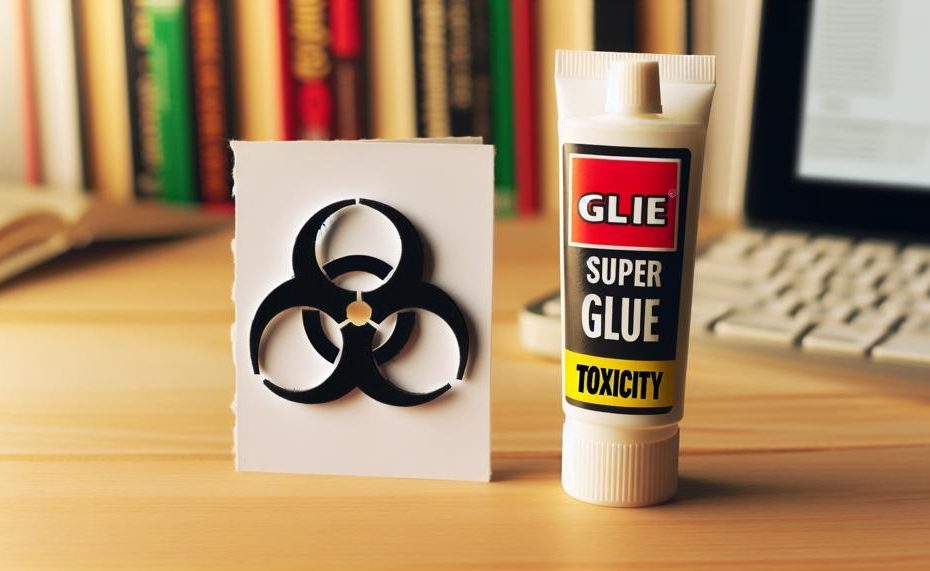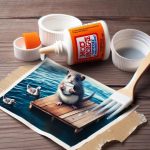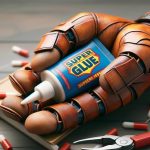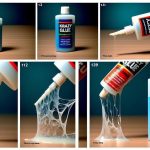Are you a fan of Krazy Glue? This seemingly harmless adhesive has been a household staple for decades, promising to bond almost any material together in seconds. But have you ever stopped to think about the potential dangers lurking in that tiny tube? In recent years, concerns have been raised about the toxicity of Krazy Glue and its impact on both our health and the environment. It’s time to take a closer look at this popular product and consider safer alternatives for all your bonding needs.
From quick fixes to DIY projects, Krazy Glue has been a go-to for many. But what exactly makes it so effective? The answer lies in its main ingredient – cyanoacrylate. While it may work wonders when it comes to bonding objects, this chemical can also cause skin irritation and respiratory issues if not handled properly. And let’s not forget about those fumes – inhaling them can be harmful, especially in poorly ventilated areas.
But the dangers of Krazy Glue don’t stop there. Improperly disposing of this adhesive can also harm wildlife and pollute water sources. And if that’s not enough to make you think twice before using it, studies have shown that long-term exposure to cyanoacrylate can lead to serious health problems.
Despite these potential risks, Krazy Glue is still widely used in homes and workplaces without much consideration for its toxicity. So why is it still so popular? Perhaps because we’ve become accustomed to its convenience or simply unaware of its potential dangers.
In this blog post, we’ll delve deeper into the toxicity of Krazy Glue and offer safer alternatives for all your bonding needs. Don’t let this seemingly innocent adhesive put your health and the environment at risk – read on to learn more.
Table of Contents
Is Krazy Glue Toxic?
Krazy Glue, a commonly used adhesive, can pose potential health risks for its users. These risks range from skin irritation to respiratory issues and ingestion. However, with proper precautions, these risks can be minimized.
One of the main concerns with using Krazy Glue is skin irritation and burns. This is due to the chemical reaction and heat generation that occurs upon contact with the glue. To prevent this, it is crucial to avoid applying the glue on open wounds or cuts.
Ingesting Krazy Glue can also lead to serious internal injuries or blockages in the digestive system. It is essential to keep the glue out of reach of children and pets to prevent accidental ingestion.
Contact with eyes can cause severe damage, including cornea damage and difficulty blinking. If you accidentally get Krazy Glue in your eyes, seek immediate medical attention to avoid any long-term consequences.
In addition, inhaling fumes from Krazy Glue can irritate the respiratory system and potentially lead to more severe conditions like bronchitis or asthma. Some people may even experience allergic reactions to the adhesive, such as redness, swelling, and difficulty breathing.
Other safety concerns include the flammability of Krazy Glue. It should be stored away from open flames or sparks and used in a well-ventilated area with protective gear.
What is Krazy Glue?
Krazy Glue, also known as instant super glue, is renowned for its exceptional bonding abilities.
It is made from a chemical called cyanoacrylate, which allows it to form strong bonds quickly and firmly with a variety of materials including ceramic, metal, wood, rubber, and plastic.
This sets it apart from traditional glues that have limited bonding capabilities.
| Features | Krazy Glue | Other Types of Glue |
| Bonding Time | Instant (within seconds) | Requires drying time (minutes to hours) |
| Materials It Can Bond To | Ceramic, metal, wood, rubber, plastic, and more | Limited range of materials |
| Toxicity | Low toxicity levels | Can be highly toxic |
| Consistency | Gel or liquid form | Solid form (sticks or paste) |
| Uses | Household repairs, crafting, and more | General purpose use |
One of the most notable differences between Krazy Glue and other types of glue is its quick bonding time. While traditional glues require several minutes to hours for drying, Krazy Glue forms bonds instantly within just a few seconds. This makes it an ideal choice for quick household repairs or crafting projects.
Furthermore, Krazy Glue has a gel or liquid consistency compared to the solid form of other glues.
This allows for precise application and the ability to fill in gaps or cracks, making it a preferred option for delicate repairs.
What are the Ingredients in Krazy Glue?
Krazy Glue is a popular adhesive known for its strong bonding capabilities. However, it contains ingredients that may pose a threat to our health if consumed or inhaled excessively.
These potential harmful substances include acetone and butylated hydroxytoluene (BHT). Both chemicals are known to cause skin irritation, respiratory problems, and eye irritation.
To ensure safe usage, it is important to handle Krazy Glue with caution and keep it out of reach of children and pets.
| Ingredient | Description | Potential Harm |
| Ethyl Cyanoacrylate | A type of superglue that creates a strong bond between surfaces quickly. | May cause skin irritation and respiratory problems if ingested or inhaled. |
| Methyl Methacrylate | A chemical used to increase the flexibility of the glue. | Prolonged exposure may result in skin irritation, respiratory problems, and eye irritation. |
| Acetone | A solvent used to dissolve the ingredients and make the glue easier to apply. | Ingestion and excessive inhalation may cause harm, while fumes can irritate the skin, respiratory system, and eyes. |
| Butylated Hydroxytoluene (BHT) | An antioxidant added to prevent the glue from drying out. | Ingestion and excessive inhalation may cause harm, while fumes can irritate the skin, respiratory system, and eyes. |
Despite these potential risks, the Environmental Protection Agency (EPA) has confirmed that Krazy Glue does not contain any hazardous substances that would require special handling or disposal.
However, it is still important to exercise caution when using this product and follow the instructions on the packaging carefully. In case of accidental ingestion, seek immediate medical attention.
How to use Krazy Glue Safely
Krazy Glue is a powerful adhesive that can be used safely with proper precautions. However, it’s important to consider the potential risks associated with its use.
These risks can be avoided by following safety tips and taking necessary precautions.
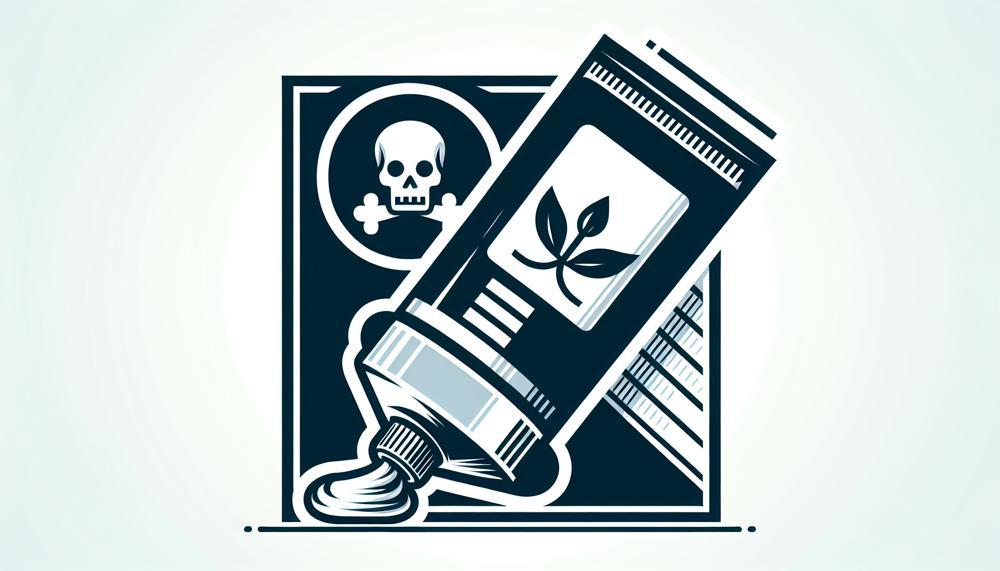
Possible Risks:
Skin Irritation or Burns:
Krazy Glue contains formaldehyde, which can cause skin irritation or burns when in contact with open wounds or eyes.
To avoid this, always wear protective gloves when handling the glue and avoid applying it on open wounds or near the eyes.
Inhalation of Harmful Fumes:
Krazy Glue’s solvents and polymers can produce harmful fumes in poorly ventilated areas, leading to respiratory issues if inhaled.
To prevent this, always use the glue in a well-ventilated area and avoid breathing in the fumes.
Ingestion:
Ingesting Krazy Glue can cause nausea, vomiting, abdominal pain, and other health issues due to its formaldehyde content.
Keep the glue out of reach of children and away from food or drinks to avoid accidental ingestion.
Flammability:
Krazy Glue is flammable and should be stored away from heat sources and open flames. It should also not be used near open flames or sparks as it can easily catch fire.
Safety Tips:
To safely use Krazy Glue and avoid these potential risks, follow these safety tips:
- Use protective gear like gloves, eye protection, and face protection.
- Work in a well-ventilated area.
- Keep away from heat sources and open flames.
- Avoid applying on open wounds or near the eyes.
- Store out of reach of children.
- Do not ingest or inhale the fumes.
- If dried out, restore it by melting it with water.
Is Krazy Glue Toxic When Dry?
When Krazy Glue dries, its toxicity level significantly decreases. This is due to the active ingredient, ethyl cyanoacrylate, being only harmful in its liquid state. Once it dries, it becomes an inert and harmless substance. However, it is still necessary to handle it with caution and avoid inhaling fumes.
| State | Toxicity Level | Risks |
| Liquid | High | Skin irritation, respiratory problems, and potential health issues if ingested or in contact with eyes. |
| Dry | Low | Possible skin irritation and fumes if inhaled. |
When Krazy Glue is in its liquid state, it is important to handle it with caution and follow safety measures. However, once it dries, it can be handled with less concern but still requires proper handling.
Additionally, the other ingredients in Krazy Glue, such as acetone and BHT, can also emit fumes and should be handled carefully. Acetone can irritate the skin and eyes, while BHT can cause respiratory problems if inhaled in large quantities.
Is Krazy Glue Toxic to the skin?
Krazy Glue, a seemingly harmless adhesive, can actually pose potential dangers to the skin and overall health if not handled properly. These dangers include skin irritation, burns, eye damage, respiratory issues, and even ingestion hazards.
To avoid these risks, it is crucial to follow safety precautions and take necessary steps to protect yourself from potential harm.
| 1. | Protect your hands by wearing protective gloves when handling Krazy Glue | Choose gloves made of nitrile or latex material for the best protection. These gloves act as a barrier between the skin and the glue, reducing the risk of irritation or burns. |
| 2. | Seek medical attention immediately if you experience skin irritation or burns | If you notice any redness, swelling, itching, or pain at the site of contact with Krazy Glue, seek medical attention immediately. Doing so will help prevent further damage and promote quicker healing. |
| 3. | Protect your eyes by wearing protective eyewear while working with Krazy Glue | Since the glue can cause immediate eye irritation and potential damage to the cornea, it is important to wear safety glasses or goggles while using it. |
| 4. | In case of accidental contact with the eyes, seek immediate medical attention | If by chance Krazy Glue gets into your eyes, do not rub or touch the affected area. Instead, seek immediate medical attention to prevent further damage to your eyesight. |
| 5. | Avoid inhaling fumes by working in a well-ventilated area or using an air purifier | Inhaling fumes from Krazy Glue can lead to respiratory issues such as coughing, wheezing, and shortness of breath. To minimize these risks, work in a well-ventilated area or use an air purifier to filter out the fumes. |
| 6. | Keep Krazy Glue out of reach of children and pets | Accidental ingestion of Krazy Glue can have harmful consequences. To prevent this, always keep it out of reach from children and pets and store it in a safe place. |
In addition to these safety precautions, it is also important to note that Krazy Glue may not be suitable for all types of projects or surfaces. It is always best to test a small area first before using it on a larger scale.
Also, be sure to carefully read and follow the instructions on the packaging for optimal results.
Is Instant Krazy Glue Toxic?
Instant Krazy Glue is generally safe for everyday use, but it’s essential to take proper safety precautions. While this adhesive is not food-safe, it can still be a convenient and effective option for various household projects and repairs.
Safety Precautions:
- Wear gloves: Krazy Glue can be harmful to the skin and may cause irritation or burns. To avoid direct contact with the glue, it is recommended to wear gloves while handling it.
- Seek medical attention: In case of skin irritation or burns from Krazy Glue, it is crucial to seek medical attention immediately. Rinse the affected area with water and avoid trying to remove the glue yourself.
- Protect your eyes: The fumes from Krazy Glue can also be harmful if inhaled or if they come into contact with the eyes. It’s important to wear protective eyewear while using this adhesive.
- Avoid inhaling fumes: Aside from protecting your eyes, it’s also vital to avoid inhaling the fumes from Krazy Glue. Always use it in a well-ventilated area and take breaks if you start to feel lightheaded or experience any discomfort.
- Keep away from children and pets: To prevent serious harm, always keep Krazy Glue out of reach of children and pets. If ingested, it can cause significant harm.
- Test on a small area: Before using Krazy Glue on a larger surface or project, it is advisable to test it on a small area first. This will help ensure that the glue does not damage or discolor the surface.
Is Krazy Glue Safe To Use on My Skin?
Krazy Glue is not recommended for use on skin, as it can cause irritation and allergic reactions. The powerful adhesive properties of Krazy Glue can result in skin damage and impede the healing of wounds if unintentionally applied to open cuts or wounds.
Furthermore, prolonged exposure to the chemicals found in Krazy Glue can have negative impacts on one’s health in the long run. Therefore, it is essential to exercise caution and prevent contact with the skin while handling this adhesive.
Accordingly, if you’re wondering, “Is Krazy Glue safe to use on my skin?” the answer is a resounding no. As someone who works with adhesives regularly, I’ve learned from personal experience that it’s crucial to be careful when working with any strong adhesives like Krazy Glue.
In fact, I once made the mistake of getting some Krazy Glue on my hand and ended up with a painful rash that took weeks to heal.
The truth is, even though Krazy Glue may seem harmless at first glance, its chemical composition is not suitable for human skin. The adhesive is known to cause severe skin irritation and allergic reactions in some people, so it’s best to avoid contact with the skin altogether.
Additionally, if you have any open cuts or wounds on your hands, it’s crucial to keep them away from any adhesives like Krazy Glue as it can delay healing and lead to further complications.
Is Krazy Glue Bad for Your Nails?
The answer is yes, and there are several ways it can harm them. This strong adhesive is not meant for use on nails and can have damaging effects such as discoloration, weakening of the nail bed, and an increased risk of infection.
To maintain healthy and strong nails, it is important to use appropriate nail glues for any nail-related tasks.
Discoloration of Nails
The chemicals in Krazy Glue are too harsh for use on nails, leading to discoloration. This can result in unsightly yellow or white spots on the nails, making them look unhealthy.
In severe cases, the glue can even eat away at the nail’s keratin, causing further damage to its strength and color.
Weakness and Breakage
Aside from discoloration, using Krazy Glue on nails can also weaken the nail bed. This makes the nails more prone to breakage and splitting, resulting in weak and brittle nails that are easily damaged.
In some cases, the glue can cause the entire nail to detach from the nail bed.
Risk of Infection
One of the most significant dangers of using Krazy Glue on nails is the increased risk of infection. If there is a gap between your natural nail and fake nail, bubbles can form which provide a breeding ground for bacteria and fungi.
This can lead to painful infections with symptoms such as swelling and pus-filled blisters.
Stick to Appropriate Nail Glues
To avoid any potential harm to your nails, it is essential to use appropriate nail glues for any nail-related tasks. These are specifically designed for use on nails and are less harsh on the skin and nails compared to other adhesives like Krazy Glue.
By using these products, you can maintain healthy and strong nails without risking any damage or infections.
Conclusion
In conclusion, while Krazy Glue may seem like a convenient solution for all our bonding needs, it’s important to note its potential toxicity.
This seemingly harmless adhesive can have serious consequences, from skin irritation and respiratory issues to harm to the environment. Therefore, it’s crucial to handle it with care and consider safer alternatives.

